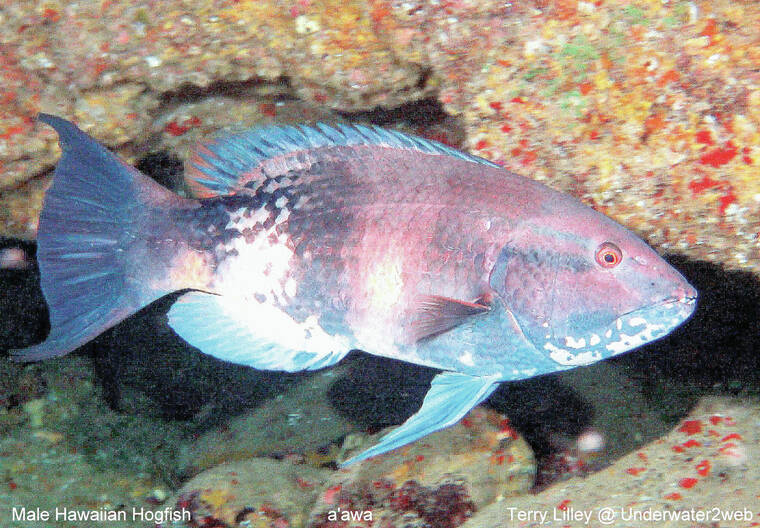Most divers in Hawai‘i have never seen this adult male fish, as it usually lives at depths of 100 feet or more, until recently! A‘awa the Hawaiian hog-fish male is over 20 inches long and has burnt red and gray colors with huge buck teeth and red eyes! In the past they have only been seen in Kaua‘i and the NW Hawaiian Islands where the water is cooler, but lately they are showing up along O‘ahu North Shore in shallow water, and I have had several professional divers ask me lately “what is that big, gray fish we are seeing?”
Most divers in Hawai‘i have never seen this adult male fish, as it usually lives at depths of 100 feet or more, until recently! A‘awa the Hawaiian hog-fish male is over 20 inches long and has burnt red and gray colors with huge buck teeth and red eyes! In the past they have only been seen in Kaua‘i and the NW Hawaiian Islands where the water is cooler, but lately they are showing up along O‘ahu North Shore in shallow water, and I have had several professional divers ask me lately “what is that big, gray fish we are seeing?”
What is so confusing about fish in the wrasse family like a‘awa is the babies, females and males look totally different! No one would ever think they are the same species, and until DNA studies no one was even sure they were the same species! In old Hawai‘i these fish often had different names for the different sexes and babies, as they looked like completely different fish, and sometimes the males do not live in the same part of the reef as the females.
The female a‘awa are bright yellow with a white stripe under the eye. We see them often in Kaua‘i while diving, but we rarely see the adult males that are gray. A‘awa like most wrasse species are all hatched out as females, and some convert into males for breeding. When the Hawaiian hog-fish convert to adult males they move into deeper water. Why? I have no idea! We really don’t know if the adult females move into deeper water to breed with the males or the males come back into shallow water to breed with the females, as these fish are quite mysterious!
Lately, for some unknown reason, the a‘awa are showing up in O‘ahu and even a few in Maui. Only 10 years ago they were only seen in Kaua‘i and the NW Hawaiian Islands. Recently at Sharks Cove in O‘ahu I got a good video clip of a huge, reddish-brown gray male in a cave at only 40 feet deep. This was super unusual, but several of the local divers have been seeing them lately.
Over the past four years there have been quite a few deep-water fish showing up close to shore here on O‘ahu, including the super-deep-water knief-jaw fish and cookie-cutter sharks, and now these big male a‘awa. I have a current special on National Geographic right now called “When Sharks Attack,” where we are looking at the military deep-water submarine activity that may be scaring these creatures up into shallow water. Something is obviously going on that is completely different than what has happened over the past 1,800 years that the Hawaiians have tracked the movements of their local marine life, so it may be good to monitor our reefs for changes that may not be good for a sustainable future!
No need to go to Mars to find new life when we have no clue about the life that exists in our oceans right here in Hawai‘i!
•••
Terry Lilley is a marine biologist living in Hanalei. He is co-founder of Reef Guardians Hawai‘i, a nonprofit on a mission to provide education and resources to protect the coral reef. To donate to Reef Guardians Hawai‘i go to www.reefguardianshawaii.org.

Subscribe today for unlimited access.
Already a subscriber?
Login
Not ready to subscribe?
Register for limited access.
If you have a print subscription but require digital access,
activate your account.




Mahalo, Terry. Always enjoy your contribution.